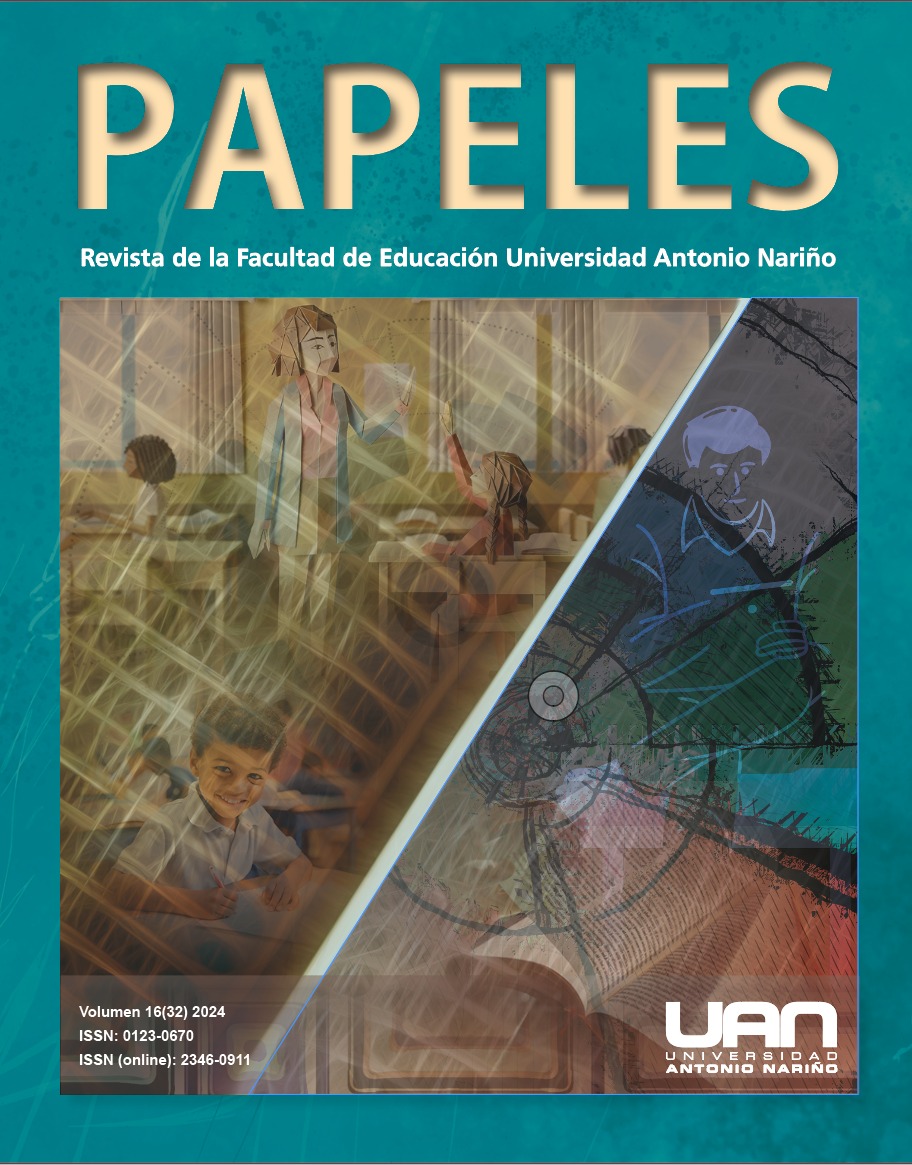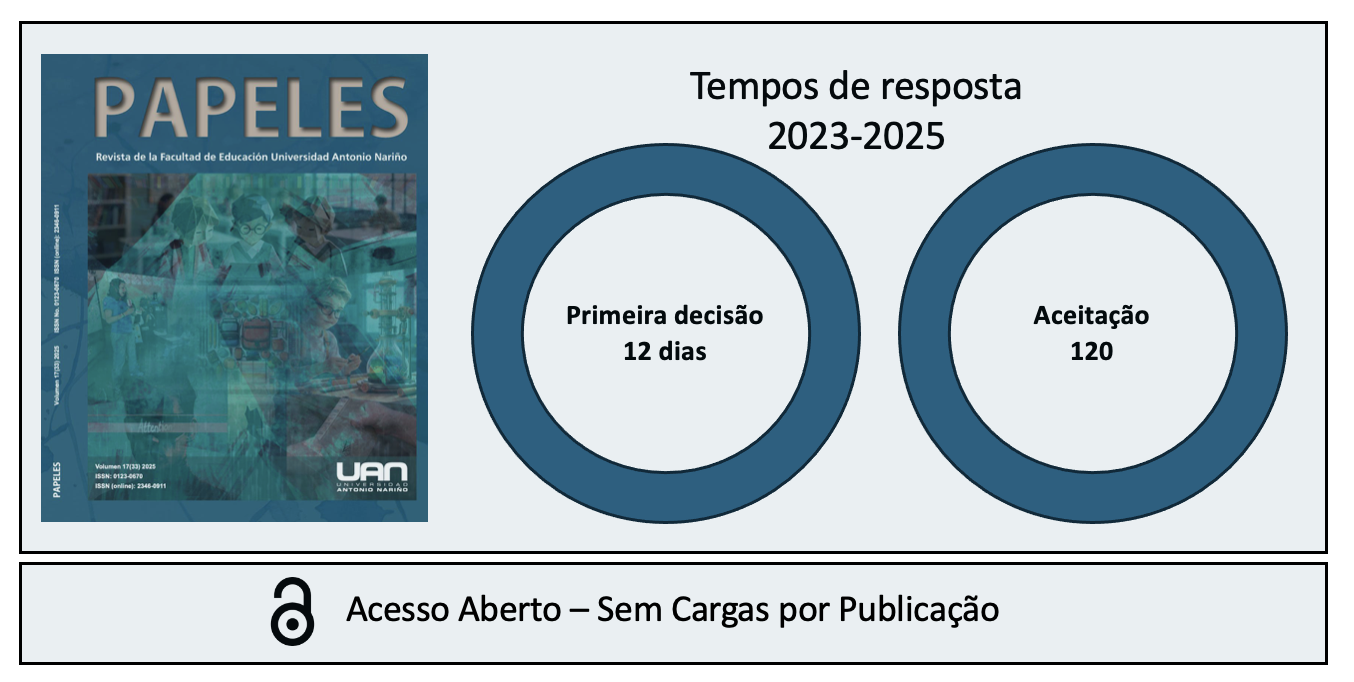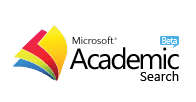Didática da leitura de quadrinhos em sala de aula: uma proposta para a formação inicial docente
Didática da leitura de quadrinhos em sala de aula: uma proposta para a formação inicial docente
DOI:
https://doi.org/10.54104/papeles.v16n32.1959Palavras-chave:
Textos multimodais, leitura de quadrinhos, didática da linguagem, formação inicial docenteResumo
Introdução: a leitura de textos multimodais, como os quadrinhos, exige que os futuros professores dominem conhecimentos disciplinares e didáticos específicos. No entanto, as pesquisas mostram que esses conhecimentos ainda são escassos. Assim, é necessário criar cursos específicos de didática da leitura de quadrinhos para que os docentes em formação estejam aptos a utilizá-los em sala de aula. Este artigo apresenta o desenho e a implementação de um programa de formação voltado ao ensino da leitura de quadrinhos, além da análise das avaliações dos participantes sobre os domínios didáticos-disciplinares e a metodologia utilizada.
Metodologia: utilizou-se uma abordagem qualitativa, especificamente um estudo de caso coletivo com 12 estudantes de Pedagogia em Língua Espanhola de uma universidade particular em Santiago, Chile. Os dados foram coletados por meio de grupo focal e analisados com o software Atlas.ti 23.
Resultados: as avaliações dos participantes se concentraram em afirmações positivas e negativas sobre os conhecimentos disciplinares-didáticos e sobre a metodologia adotada.
Conclusão: o estudo oferece contribuições e lições pedagógicas importantes que devem ser consideradas na elaboração de programas de formação inicial docente voltados ao ensino da leitura de quadrinhos no ensino médio.
Downloads
Referências
Afflerbach, P., Hurt, M. y Cho, B. Y. (2020). Reading comprehension strategy instruction. En D. L. Dinsmore, L. K. Fryer y M. M. Parkinson (eds.), Handbook of strategies and strategic processing (pp. 98-118). Routledge. https://doi.org/10.4324/9780429423635 DOI: https://doi.org/10.4324/9780429423635-7
Almasi, J. F. y Fullerton, S. K. (2012). Teaching strategic processes in reading. Guilford Press.
Avarogullari, A. K. y Mutlu, Z. (2019). Pre-service social studies teachers’ opinions on using comic books in social studies teaching. Asian Journal of Education and Training, 5(4), 538-547. 10.20448/journal.522.2019.54.538.547 DOI: https://doi.org/10.20448/journal.522.2019.54.538.547
Ayala García, P. y Santos Sánchez, H. (2020). El webcómic interactivo como narrativa transdisciplinar en la era de la cultura digital. Estudios sobre las Culturas Contemporáneas, 26(52), 71-90. https://www.redalyc.org/journal/316/31664009005/31664009005.pdf
Barbour, R. (2013). Los grupos de discusión en investigación cualitativa. Morata.
Bartow Jacobs, K. y Low, D. E. (2017). Critical questioning in and beyond the margins: Teacher preparation students’ multimodal inquiries into literacy assessment. English Education, 49(3), 226-264. https://doi.org/10.58680/ee201729042 DOI: https://doi.org/10.58680/ee201729042
Bemiss, E. M. y Keel, M. G. (2021). Meeting the needs of all students: Fostering the use of graphic novels among pre-and in-service teachers. Journal of Literacy Innovation, 6(1), 75-94. https://ircommons.uwf.edu/esploro/outputs/journalArticle/Meeting-the-needs-of-all-students/99380090886006600/filesAndLinks?index=0
Boerman‐Cornell, W. (2016). The intersection of words and pictures: Second through fourth graders read graphic novels. The Reading Teacher, 70(3), 327-335. DOI: https://doi.org/10.1002/trtr.1525
Braun, V. y Clarke, V. (2006). Using thematic analysis in psychology. https://doi.org/10.1002/trtr.1525 Qualitative Research in Psychology, 3(2), 77-101. https://doi.org/10.1191/1478088706qp063oa DOI: https://doi.org/10.1191/1478088706qp063oa
Braun, V. y Clarke, V. (2019). Reflecting on reflexive thematic analysis. Qualitative Research in Sport, Exercise and Health, 11(4), 589-597. https://doi.org/10.1080/2159676x.2019.1628806 DOI: https://doi.org/10.1080/2159676X.2019.1628806
Brozo, W. G., Moorman, G. y Meyer, C. (2014). Wham! Teaching with graphic novels across the curriculum. Teachers College Press.
Centro de Perfeccionamiento, Experimentación e Investigaciones Pedagógicas. (2022). Estándares pedagógicos y disciplinarios para carreras de Pedagogía en lenguaje educación media. https://estandaresdocentes.mineduc.cl/wp-content/uploads/2023/05/EPD-Lenguaje-Media.pdf
Cho, H. (2021). The platformization of culture: Webtoon platforms and media ecology in Korea and beyond. The Journal of Asian Studies, 80(1), 73-93. https://doi.org/10.1017/S0021911820002405 DOI: https://doi.org/10.1017/S0021911820002405
Clark, J. S. (2013). “Your credibility could be shot”: Preservice teachers’ thinking about nonfiction graphic novels, curriculum decision making, and professional acceptance. The Social Studies, 104(1), 38-45. https://doi.org/10.1080/00377996.2012.665957 DOI: https://doi.org/10.1080/00377996.2012.665957
Clark, J. S. y Camicia, S. P. (2014). Fostering preservice teachers’ sense of historical agency through the use of nonfiction graphic novels. The Journal of Social Studies Research, 38(1), 1-13. https://doi.org/10.1016/j.jssr.2013.12.001 DOI: https://doi.org/10.1016/j.jssr.2013.12.001
Clark, S. K., Helfrich, S. R. y Hatch, L. (2015). Examining preservice teacher content and pedagogical content knowledge needed to teach reading in elementary school. Journal of Research in Reading, 40(3), 219-232. https://doi.org/10.1111/1467-9817.12057 DOI: https://doi.org/10.1111/1467-9817.12057
Cohn (2024). The patterns of comics: Visual languages of comics from Asia, Europe, and North America. Bloomsburry. DOI: https://doi.org/10.5040/9781350381636
Cohn, N. (2021). Who understands comics? Questioning the universality of visual language comprehension. Bloomsburry Academic. DOI: https://doi.org/10.5040/9781350156074
Connors, S. P. (2012). Altering perspectives: How the implied reader invites us to rethink the difficulty of graphic novels. The Clearing House: A Journal of Educational Strategies, Issues and Ideas, 85(1), 33-37. https://doi.org/10.1080/00098655.2011.607476 DOI: https://doi.org/10.1080/00098655.2011.607476
Connors, S. P. (2017). Designing meaning: A multimodal perspective on comics reading. En C. Hill (ed.), Teaching comics through multiple lenses: Critical perspectives (pp. 13-29). Routledge. https://doi.org/10.4324/9781315625638 DOI: https://doi.org/10.4324/9781315625638
Cook, M. P. (2017). Now I “see”: The impact of graphic novels on reading comprehension in high school English classrooms. Literacy Research and Instruction, 56(1), 21-53. https://doi.org/10.1080/19388071.2016.1244869 DOI: https://doi.org/10.1080/19388071.2016.1244869
Cook, M. y Sams, B. (2018). A different kind of sponsorship: The influence of graphic narrative composing on ELA pre-service teachers’ perceptions of writing and literacy instruction. Journal of Language and Literacy Education, 14(1), 1-25. https://files.eric.ed.gov/fulltext/EJ1175831.pdf
Dallacqua, A. K. (2020). Reading comics collaboratively and challenging literacy norms. Literacy Research and Instruction, 59(2), 169-190. https://doi.org/10.1080/19388071.2019.1669746 DOI: https://doi.org/10.1080/19388071.2019.1669746
Darling-Hammond, L., Hyler, M. E. y Gardner, M. (2017). Effective teacher professional development. Learning Policy Institute. DOI: https://doi.org/10.54300/122.311
Dillon, D. R., O’Brien, D. G., Sato, M. y Kelly, C. M. (2010). Professional development and teacher education for reading instruction. En M. L. Kamil, P. D. Pearson, E. Birr Moje y P. Afflerbach (eds.), Handbook of reading research (vol. 4, pp. 629-660). Routledge. https://doi.org/10.4324/9780203840412 DOI: https://doi.org/10.4324/9780203840412
Duncan, R., Smith, M. y Levitz, P. (2023). The power of comics and graphic novels: Culture, form and context. Bloomsbury.
El Refaie, E. (2019). Visual metaphor and embodiment in graphic illness narratives. Oxford University Press. DOI: https://doi.org/10.1093/oso/9780190678173.001.0001
Fisher, P. (2019). Comics as communication: A functional approach. Palgrave Macmillan.
Flick, U. (2004). Introducción a la investigación cualitativa. Morata.
Garvis, S. (2015). Narrative constellations: Exploring lived experience in education. Sense. DOI: https://doi.org/10.1007/978-94-6300-151-9
Gavaldón-Hernández, G., Gerbolés-Sánchez, A. y Saez de Adana, F. (2017) Use of graphic narratives with preservice teachers as a mediated learning tool. International Journal of Social Sciences, 3(2), 1323-1336. https://doi.org/10.20319/pijss.2017.32.13231336 DOI: https://doi.org/10.20319/pijss.2017.32.13231336
Gavaldón-Hernández, G., Gerbolés-Sánchez, A. y Saez de Adana, F. (2020). Aprender a comunicar con imágenes: Uso del comic en la educación superior como vehículo para el desarrollo de competencias multimodales. Cuadernos del Centro de Estudios en Diseño y Comunicación: Ensayos, 89, 142-166. https://doi.org/10.18682/cdc.vi89.3801 DOI: https://doi.org/10.18682/cdc.vi89.3801
Gravett, P. (2004). Manga: La era del nuevo comic. H Kliczkowski.
Gritter, K., Bian, X., Van Duinen, D. y Boerman-Cornell, B. (2023). Teaching graphic novels to adolescent multilingual (and all) learners: Universal design, pedagogy, and practice. Taylor & Francis. DOI: https://doi.org/10.4324/9781003283508
Groensteen, T. (2021). Sistema de la historieta. Nauta Colecciones Editores.
Hikida, M., Chamberlain, K., Tily, S., Daly-Lesch, A., Warner, J. R. y Schallert, D. L. (2019). Reviewing how preservice teachers are prepared to teach reading processes: What the literature suggests and overlooks. Journal of Literacy Research, 51(2), 177-195. https://doi.org/10.1177/1086296X19833297 DOI: https://doi.org/10.1177/1086296X19833297
Ibarra-Rius, N. y Ballester-Roca, J. (2022). El cómic desde la educación lectora: Confluencias, interrogantes y desafíos para la investigación. Ocnos: Revista de estudios sobre lectura, 21(1). https://doi.org/10.18239/ocnos_2022.21.1.2753 DOI: https://doi.org/10.18239/ocnos_2022.21.1.2753
Jaffe, M. y Hurwich, T. (2018). Worth a thousand words: Using graphic novels to teach visual and verbal literacy. John Wiley & Sons. DOI: https://doi.org/10.1002/9781119548690
Jiménez Arriagada, V. y Sánchez Sánchez, J. (2022). Criterios de selección de cómics para el plan lector de Enseñanza Media. Árboles y Rizomas, 4(1), 48-66. https://doi.org/10.35588/ayr.v4i1.5020 DOI: https://doi.org/10.35588/ayr.v4i1.5020
Jiménez Arriagada, V., Bañales-Faz, G. y Lobos-Sepúlveda, M. T. (2020). Investigaciones del comic en el área de la didáctica de la lengua y la literatura en Hispanoamérica. Revista Mexicana de Investigacion Educativa, 25(85), 375-393. https://www.scielo.org.mx/pdf/rmie/v25n85/1405-6666-rmie-25-85-375.pdf
Jiménez, L. M., Roberts, K. L., Brugar, K. A., Meyer, C. K. y Waito, K. (2017). Moving our can (n) ons: Toward an appreciation of multimodal texts in the classroom. The Reading Teacher, 71(3), 363-368. https://doi.org/10.1002/trtr.1630 DOI: https://doi.org/10.1002/trtr.1630
Kirtley, S. E., Garcia, A. y Carlson, P. E. (eds.) (2020). With great power comes great pedagogy: Teaching, learning, and comics. University Press of Mississippi. DOI: https://doi.org/10.14325/mississippi/9781496826046.001.0001
Kress, G. y Van Leeuwen, T. (2020). Reading images: The grammar of visual design. Routledge. DOI: https://doi.org/10.4324/9781003099857
Kwon, H. (2020). Graphic novels: Exploring visual culture and multimodal literacy in preservice art teacher education. Art Education, 73(2), 33-42. https://doi.org/10.1080/00043125.2019.1695479 DOI: https://doi.org/10.1080/00043125.2019.1695479
Manghi Haquin, D. (2012). La perspectiva multimodal sobre la comunicación: Desafíos y aportes para la enseñanza en el aula. Revista Electrónica Diálogos Educativos (REDE), 11(22), 4-15. https://revistas.umce.cl/index.php/dialogoseducativos/article/view/1067/2649
Mathews, S. A. (2011). Framing preservice teachers’ interpretations of graphic novels in the Social Studies Classroom. Theory & Research in Social Education, 39(3), 416-446. https://doi.org/10.1080/00933104.2011.10473461 DOI: https://doi.org/10.1080/00933104.2011.10473461
Mazur, D. y Danner, A. (2014). Cómics: Una historia global, desde 1968 hasta hoy. Blume.
McClanahan, B. J. (2022). Experiencing historical fiction graphic novels to teach social studies: Preservice teachers learn why and how. Study & Scrutiny: Research on Young Adult Literature, 5(2), 95-119. https://doi.org/10.15763/issn.2376-5275.2022.5.2.95-119 DOI: https://doi.org/10.15763/issn.2376-5275.2022.5.2.95-119
McClanahan, B. J. y Nottingham, M. (2019). A suite of strategies for navigating graphic novels: A dual coding approach. The Reading Teacher, 73(1), 39-50. https://doi.org/10.1002/trtr.1797 DOI: https://doi.org/10.1002/trtr.1797
McCloud, S. (2014). Entender el comic: El arte invisible. Astiberri.
McGrail, E., Rieger, A. y Doepker, G. M. (2017). Pre-service teachers’ perceptions about the effectiveness of the TOON comic books in their guided reading instruction. Georgia Educational Researcher, 14(1), 1-39. https://scholarworks.gsu.edu/cgi/viewcontent.cgi?article=1109&context=mse_facpub
McGrail, E., Rieger, A., Doepker, G. M. y McGeorge, S. (2018). Pre-service teachers’ perspectives on how the use of TOON comic books during guided reading influenced learning by struggling readers. SANE Journal: Sequential Art Narrative in Education, 2(3), 1-28. https://scholarworks.gsu.edu/cgi/viewcontent.cgi?article=1113&context=mse_facpub DOI: https://doi.org/10.20429/ger.2017.140101
Merriam, S. B. y Tisdell, E. J. (2016). Qualitative research: A guide to design and implementation. John Wiley & Sons.
Meyer, C. K. y Jiménez, L. M. (2017). Using every word and image: Framing graphic novel instruction in the expanded four resources model. Journal of Adolescent & Adult Literacy, 61(2), 153-161. https://doi.org/10.1002/jaal.666 DOI: https://doi.org/10.1002/jaal.666
Mohd Yusof, S., Mohd Lazim, Z. y Salehuddin, K. (2017). Teacher trainees’ perspectives of teaching graphic novels to ESL primary schoolers. 3L: The Southeast Asian Journal of English Language Studies, 23(3), 81-96. http://doi.org/10.17576/3L-2017-2303-06 DOI: https://doi.org/10.17576/3L-2017-2303-06
Nottingham, M., McClanahan, B. y Atkinson, H. (2022). Evaluating a suite of strategies for reading graphic novels: A confirmatory case study. SANE Journal: Sequential Art Narrative in Education, 2(7), 1-39. https://digitalcommons.unl.edu/cgi/viewcontent.cgi?article=1063&context=sane
Page, R. (2010). New perspectives on narrative and multimodality. Routledge. DOI: https://doi.org/10.4324/9780203869437
Patton, M. Q. (2002). Qualitative research & evaluation methods: Integrating theory and practice (3.ª ed.). SAGE.
Pazaer, N. y Assaiqeli, A. (2023). Pre-service teachers’ views on using english comics to improve pupils’ english language skills. Studies in English Language and Education, 10(1), 197-215. https://doi.org/10.24815/siele.v10i1.21836 DOI: https://doi.org/10.24815/siele.v10i1.21836
Peeters, B. (1998). Lire la bande dessinée. Flammarion.
Reid, S. F. y Moses, L. (2019). Students become comic book Author‐Illustrators: Composing with words and images in a Fourth‐Grade comics writers’ workshop. The Reading Teacher, 73(4), 461-472. https://doi.org/10.1002/trtr.1864 DOI: https://doi.org/10.1002/trtr.1864
Roberts, K. L., Meyer, C. K., Brugar, K. A. y Jimenez, L. M. (2020). Integrative and illustrative: Multimodal acquisition, comprehension, and composition. Middle School Journal, 51(4), 9-17. https://doi.org/10.1080/00940771.2020.1787748 DOI: https://doi.org/10.1080/00940771.2020.1787748
Romagnoli, A., Bazler, J. y Van Sickle, M. (2018). Science education and the graphic novel connection: Pre-service teachers and the creation of graphic novelettes. Science Educator, 26(2), 73-80. https://files.eric.ed.gov/fulltext/EJ1263520.pdf
Rose, G. (2016). Visual methodologies: An introduction to research with visual materials. SAGE.
Rovira-Collado, J., Ruiz-Bañuls, M., Martínez-Carratalá, F. y Gómez-Trigueros, I. (2021). Intertextualidad y multimodalidad en constelaciones transmedia: Una propuesta interdisciplinar en la formación docente. Tejuelo, 34, 111-142. https://doi.org/10.17398/1988-8430.34.111 DOI: https://doi.org/10.17398/1988-8430.34.111
Saldaña, J. (2021). The coding manual for qualitative researchers. SAGE.
Serafini, F. (2011). Expanding perspectives for comprehending visual images in multimodal texts. Journal of Adolescent & Adult Literacy, 54(5), 342-350. https://doi.org/10.1598/JAAL.54.5.4 DOI: https://doi.org/10.1598/JAAL.54.5.4
Serafini, F. (2012a). Expanding the four resources model: Reading visual and multimodal texts. Pedagogies: An International Journal, 7(2), 150-164. https://doi.org/10.1080/1554480X.2012.656347 DOI: https://doi.org/10.1080/1554480X.2012.656347
Serafini, F. (2012b). Reading multimodal texts in the 21st century. Research in the Schools, 19(1), 26-32. https://cfpjs1.wordpress.com/wp-content/uploads/2013/03/serafini_2012.pdf
Serafini, F. (2014). Reading the visual: An introduction to teaching multimodal literacy. Columbia University.
Serafini, F. (2017). Visual literacy. En Oxford Research Encyclopedia of Education. https://doi.org/10.1093/acrefore/9780190264093.013.19 DOI: https://doi.org/10.1093/acrefore/9780190264093.013.19
Shulman, L. (1986). Those who understand: Knowledge growth in teaching. Educational Researcher, 15(2), 4-14. http://ereserve.library.utah.edu/Annual/TEACH/6800/Bates/understand.pdf DOI: https://doi.org/10.3102/0013189X015002004
Smith, J. M. y Pole, K. (2018). What’s going on in a graphic novel? The Reading Teacher, 72(2), 169-177. https://doi.org/10.1002/trtr.1695 DOI: https://doi.org/10.1002/trtr.1695
Smyth, T. (2022). Teaching with comics and graphic novels: Fun and engaging strategies to improve close reading and critical thinking in every classroom. Routledge. DOI: https://doi.org/10.4324/9781003291671
Stake, R. E. (1998). Investigación con estudio de casos. Morata.
Wallner, L. (2019). Gutter talk: Co-constructing narratives using comics in the classroom. Scandinavian Journal of Educational Research, 63(6), 819-838. https://doi.org/10.1080/00313831.2018.1452290 DOI: https://doi.org/10.1080/00313831.2018.1452290
Zhao, F. y Mahrt, N. (2018). Influences of comics expertise and comics types in comics reading. International Journal of Innovation and Research in Educational Sciences, 5, 2349-5219. https://www.ijires.org/administrator/components/com_jresearch/files/publications/IJIRES_1226_FINAL1.pdf
Downloads
Publicado
-
Resumo723
-
PDF (Español)83
-
LENS (Español)12
-
XML (Español)36
Como Citar
Edição
Seção
Categorias
Licença
Copyright (c) 2024 Victoria Jiménez Arriagada, Gerardo Bañales Faz

Este trabalho está licenciado sob uma licença Creative Commons Attribution-NoDerivatives 4.0 International License.





